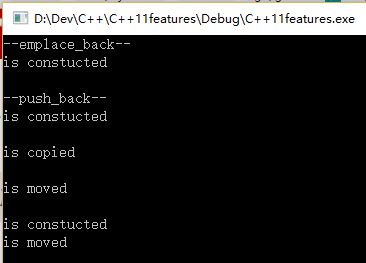前言
一直以来写代码,vector想都没想就是push_back,今天发现的C++11的emplace_back碾压了传统的push_back
总结一句话:Life is short, use emplace_back()。
简单叙述原因:emplace_back可以“同时构造和插入,一次搞定”,push_back需要“先构造,后插入,而且插入的时候还伴随着拷贝或者移动”。
Talk is cheap, show me the code
#include <iostream>
#include <utility>
#include <chrono>
#include <vector>
#include <string>
using namespace std;
using namespace chrono;
int main()
{
vector<string> v;
int num = 100000;
v.reserve(num); // capacity 一次性增大到十万,减少vector多次增大时候的拷贝次数
cout << "push_back way one: ";
auto start = system_clock::now();
for (int i = 0; i < num; ++i)
{
string temp("caitao");
v.push_back(temp); // push_back(const string&),参数是左值引用
}
auto end = system_clock::now();
auto duration = duration_cast<microseconds>(end - start);
cout << duration.count() << " microseconds." << endl << endl;
cout << "push_back way two: ";
v.clear();
start = system_clock::now();
for (int i = 0; i < num; ++i)
{
string temp("caitao");
v.push_back(move(temp)); // push_back(string &&), 参数是右值引用。
// move可以理解为类型转换:左值引用 → 右值引用。右值引用就是临时对象。
}
end = system_clock::now();
duration = duration_cast<microseconds>(end - start);
cout << duration.count() << " microseconds." << endl << endl;
cout << "push_back way three: ";
v.clear();
start = system_clock::now();
for (int i = 0; i < num; ++i)
{
v.push_back(string("caitao")); // push_back(string &&), 参数是右值引用
}
end = system_clock::now();
duration = duration_cast<microseconds>(end - start);
cout << duration.count() << " microseconds." << endl << endl;
cout << "push_back way four: ";
v.clear();
start = system_clock::now();
for (int i = 0; i < num; ++i)
{
v.push_back("caitao"); // push_back(string &&),参数是右值引用,和 way three 几乎一样(只有vector元素是string才可以这么写,为了C++和C的字符串兼容)
}
end = system_clock::now();
duration = duration_cast<microseconds>(end - start);
cout << duration.count() << " microseconds." << endl << endl;
cout << "emplace_back(fastest): ";
v.clear();
start = system_clock::now();
for (int i = 0; i < num; ++i)
{
v.emplace_back("caitao"); // 只有一次构造函数,不调用拷贝构造函数,速度最快
}
end = system_clock::now();
duration = duration_cast<microseconds>(end - start);
cout << duration.count() << " microseconds." << endl << endl;
system("pause");
return 0;
}
分析
第一种方法,速度最慢。push_back的参数是左值引用。首先定义一个temp对象的时候,调用一次构造函数,然后push_back的时候调用一次拷贝构造函数。两次构造很花时间,因为内存里面需要重新分配空间。
第二~四种方法,速度中等。push_back的参数是右值引用。首先定义一个temp对象的时候,调用一次构造函数,然后push_back的时候调用一次移动构造函数。移动构造函数花的时间比拷贝构造函数花的时间少,因为不需要内存重新分配空间。(不知道为什么第二种方法会比方法三和四花费的时间多一点点。。。)
第五种方法,即emplace_back速度最快,因为emplace_back只调用一次构造函数,没有移动构造函数,也没有拷贝构造函数。cplusplus.com说:Arguments forwarded to construct the new element. 意思是:emplace_back的参数就是构造函数的参数。
证明上述的分析
写一个类,重载构造函数,重载拷贝构造函数,重载移动构造函数。代码如下:
#include <vector>
#include <string>
#include <iostream>
using namespace std;
struct Complicated
{
int year;
double country;
string name;
Complicated(int a, double b, string c) :year(a), country(b), name(c)
{
cout << "is constucted" << endl;
}
Complicated(const Complicated & other) : year(other.year), country(other.country), name(other.name)
{
cout << "is copied" << endl;
}
Complicated(Complicated && other) : year(move(other.year)), country(move(other.country)), name(move(other.name))
{
cout << "is moved" << endl;
}
};
int main()
{
int anInt = 4;
double aDouble = 5.0;
string aString = "C++";
vector<Complicated> v;
v.reserve(10);
cout << "--emplace_back--" << endl;
v.emplace_back(anInt, aDouble, aString); // construct
cout << endl << "--push_back--" << endl;
Complicated temp(anInt, aDouble, aString); // construct
cout << endl;
v.push_back(temp); // copy
cout << endl;
v.push_back(move(temp)); // move
cout << endl;
v.push_back(Complicated(anInt, aDouble, aString)); // construct + move
cout << endl;
system("pause");
return 0;
}
输出结果如下:
一种“更加公平”的比较方式
emplace_back可以“构造和插入同时进行”,堪称“开挂”。如果对象构造好了,只是单纯的比较插入(抛开外挂),谁快一些呢?
这次是“单纯”比较的push_back和emplace_back的插入功能:
#include <iostream>
#include <utility>
#include <chrono>
#include <vector>
#include <string>
using namespace std;
using namespace chrono;
int main()
{
vector<string> v;
int num = 100000;
v.reserve(num); // capacity 一次性增大到十万,减少vector多次增大时候的拷贝次数
string caitao("caitao");
vector<string> storage(num, caitao);
cout << "push_back(copy): ";
auto start = system_clock::now();
for (int i = 0; i < num; ++i)
{
v.push_back(storage[i]);
}
auto end = system_clock::now();
auto duration = duration_cast<microseconds>(end - start);
cout << duration.count() << " microseconds." << endl << endl;
cout << "push_back:(move): ";
v.clear();
start = system_clock::now();
for (int i = 0; i < num; ++i)
{
v.push_back(move(storage[i]));
}
end = system_clock::now();
duration = duration_cast<microseconds>(end - start);
cout << duration.count() << " microseconds." << endl << endl;
cout << "emplace_back: ";
v.clear();
start = system_clock::now();
for (int i = 0; i < num; ++i)
{
v.emplace_back(storage[i]);
}
end = system_clock::now();
duration = duration_cast<microseconds>(end - start);
cout << duration.count() << " microseconds." << endl << endl;
system("pause");
return 0;
}emplace_back最快,push_back(move())次之,push_back最慢。所以呀,大家忘了push_back吧(除非特殊情况,比如?)
last update: 2017/5/10

























 375
375

 被折叠的 条评论
为什么被折叠?
被折叠的 条评论
为什么被折叠?








